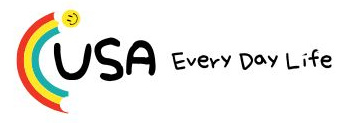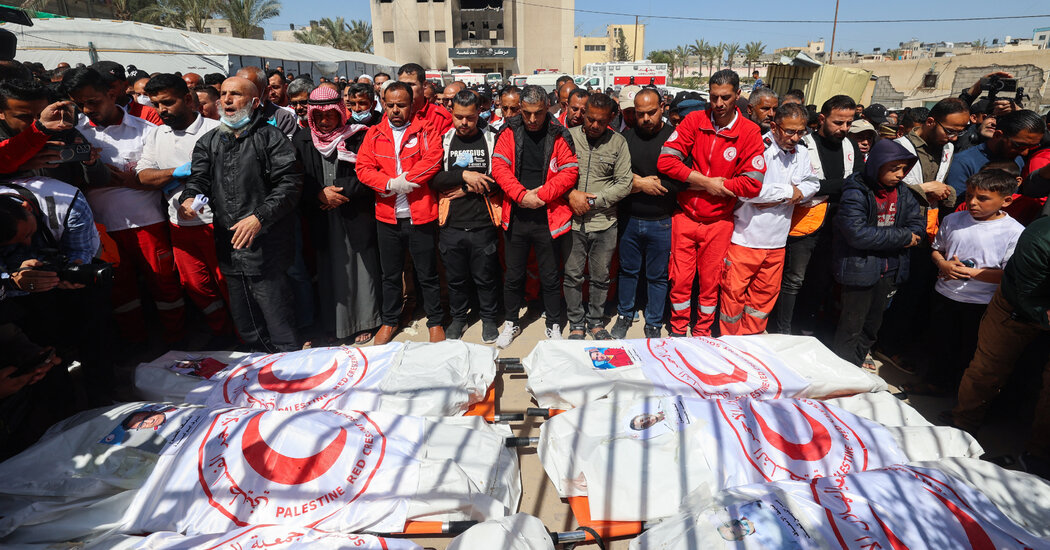Days after the United Nations accused Israel of killing 15 humanitarian workers in Gaza, officials who recovered the bodies or carried out the autopsies said some of the rescue workers were shot multiple times before being buried in a mass grave.
The Palestine Red Crescent Society, which had eight of its members killed and carried out the recovery mission, said that nearly all 15 bodies showed gunshot wounds, according to a spokeswoman, Nebal Farsakh. One paramedic was found with his hands and feet tied toward his body, Ms. Farsakh said.
“My colleagues were shot; the bodies who were retrieved, many of them have multiple gun shots. We found all of them thrown in a mass grave, the bodies were put next to each other and covered with sand,” said Ms. Farsakh in a telephone interview from Ramallah.
The deaths of the aid workers, who first went missing on March 23, have drawn international condemnation in recent days.
On that day, in the southern Gaza city of Rafah, ambulances and a U.N. vehicle came under attack from Israel’s military, then went silent. On Sunday, rescue teams found 15 bodies, most in a shallow mass grave along with their crushed ambulances and the vehicle marked with the U.N. logo. The United Nations, which is typically cautious about assigning blame, accused Israel of killing them.
An Israeli military spokesman, Lt. Col. Nadav Shoshani, said on X on Monday that nine of those killed were Palestinian militants. He said Israeli forces “did not randomly attack” an ambulance, but that several vehicles “were identified advancing suspiciously” without headlights or emergency signals toward Israeli troops, prompting them to shoot.
“When Hamas terrorists operate in active combat zones — while using humanitarian vehicles as cover, launching rockets from hospitals and stealing aid — Israel will do whatever it takes to protect its soldiers and citizens,” said Jonathan Harounoff, a spokesman for Israel’s mission to the U.N.
Dr. Ahmad Dhair, a forensic expert at the Nasser hospital in the Gazan city of Khan Younis, examined five bodies belonging to the humanitarian workers on Monday. He said in a telephone interview from Gaza that he had found multiple bullet wounds in four of the bodies and some appeared shot at close range. The fifth was decomposed beyond recognition, Dr. Dhair said.
He plans to examine the rest of the bodies on Thursday. One of the four had bruises on the wrist with linear marks on the skin, Dr. Dhair said, adding that further investigations were required to determine if any of the victims had been tied up.
“Some of them were shot in the head from behind,” Dr. Dhair said. He said he also saw gunshot wounds in the torso and the chest, adding that the shoulder and elbow joints were also targeted.
Dr. Dhair’s assessment was first reported in The Guardian.
Two senior U.N. officials and a senior official from the International Federation of Red Cross and Red Crescent Societies confirmed they had seen reports from colleagues on the ground who took part in the recovery mission that indicated the humanitarian workers had been shot. The officials asked not to be named because they were not authorized to comment publicly.
The United Nations in New York on Wednesday also gave more details of what occurred on March 23, saying the attack was a grave violation of laws protecting humanitarian workers in conflict zones. The organization called for an independent investigation.
Jonathan Whittall, the head of U.N.’s humanitarian agency for the Palestinian territories, said that all the paramedics, members of the Palestine Red Crescent Society and the Civil Defense, were still wearing their uniforms and gloves when they were found. They had been traveling in marked vehicles and had not posed a threat to anyone, he added.
“They were being dispatched into Rafah as Israeli forces were advancing into the area. The ambulances were hit one by one as they advanced, as they entered into Rafah,” said Mr. Whittall, who participated in the rescue operation and was among the team who found the bodies.
Ms. Farsakh said the humanitarian workers had not carried any weapons and had been dispatched to aid wounded civilians caught in Israeli strikes.
One member of the Palestine Red Crescent Society is still missing. And one other, who was riding in the first ambulance, was detained by the Israeli military and later released, Ms. Farsakh said. He recounted that Israel sprayed the ambulances with heavy gunfire, and two of his colleagues sitting in the front were killed, Ms. Farsakh said.
Ms. Farsakh said in addition to their field findings and witness testimony indicating that Israel killed the aid workers, one of the paramedics in an ambulance called the dispatch center while they were under attack, reporting that the Israeli military had opened fire on their convoy and all of them were injured.





